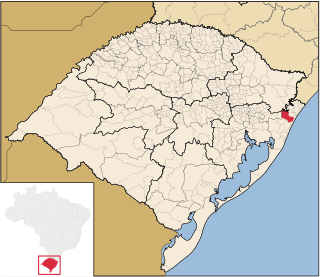Related Research Articles

Madeira, officially the Autonomous Region of Madeira, is one of two autonomous regions of Portugal, the other being the Azores. It is an archipelago situated in the North Atlantic Ocean, in a region known as Macaronesia, just under 400 kilometres (250 mi) to the north of the Canary Islands and 520 kilometres (320 mi) west of the Kingdom of Morocco. Madeira is geologically located on the African Tectonic Plate, although it is culturally, politically and ethnically associated with Europe, with its population predominantly descended from original Portuguese settlers. Its population was 251,060 in 2021. The capital of Madeira is Funchal, which is located on the main island's south coast.

This article is about the demography of the population of Trinidad and Tobago including population density, ethnicity, education level, health of the populace, economic status, religious affiliations and other aspects of the population.

Porto Santo Island is a Portuguese island 43 kilometres (27 mi) northeast of Madeira Island in the North Atlantic Ocean; it is the northernmost and easternmost island of the archipelago of Madeira, located in the Atlantic Ocean west of Europe and Africa.
Afro-Trinidadians and Tobagonians are people from Trinidad and Tobago who are of Sub-Saharan African descent, mostly from West Africa. Social interpretations of race in Trinidad and Tobago are often used to dictate who is of West African descent. Mulatto-Creole, Dougla, Blasian, Zambo, Maroon, Pardo, Quadroon, Octoroon or Hexadecaroon (Quintroon) were all racial terms used to measure the amount of West African ancestry someone possessed in Trinidad and Tobago and throughout North American, Latin American and Caribbean history.
Portuguese Americans, also known as Luso-Americans (luso-americanos), are citizens and residents of the United States who are connected to the country of Portugal by birth, ancestry, or citizenship.
Portuguese Canadians are Canadian citizens of full or partial Portuguese heritage or people who migrated from Portugal and reside in Canada. According to the 2021 Census, there were 448,310 or 1.21% of Canadians claimed full or partial Portuguese ancestry, a decrease compared to 482,110 in 2016.

Clube de Futebol União, commonly known as União or União da Madeira, was a Portuguese football club based in Funchal, Madeira, notable for its six appearances in the Portuguese top-flight Primeira Liga, between the 1989–90 and 1991–92 seasons, the 1993–94 and 1994–95 seasons and most recently in the 2015–16 season.

Queimados is a municipality located in the Brazilian state of Rio de Janeiro. Its population was 151,335 (2020) and its area is 75 km2. The city is divided into 37 districts.
Carlos Alberto is a common Portuguese and Spanish given name.
Chinese Trinidadians and Tobagonians are Trinidadians and Tobagonians of Han Chinese ancestry. The group includes people from Mainland China, Hong Kong, and Overseas Chinese who have immigrated to Trinidad and Tobago and their descendants, including those who have emigrated to other countries. The term is usually applied both to people of mixed and unmixed Chinese ancestry, although the former usually appear as mixed race in census figures. Chinese settlement began in 1806. Between 1853 and 1866 2,645 Chinese immigrants arrived in Trinidad as indentured labour for the sugar and cacao plantations. Immigration peaked in the first half of the twentieth century, but was dramatically lowered after the Chinese Communist Revolution in 1949. After peaking at 8,361 in 1960, the unmixed Chinese population in Trinidad declined to 3,800 in 2000, however slightly increased to 3,984 in 2011.
Chinese Caribbeans are people who are predominantly of Han Chinese ethnic origin living in the Caribbean. There are small but significant populations of Chinese and their descendants in all countries of the Greater Antilles. They are all part of the large Chinese diaspora known as Overseas Chinese.

Maquiné is a municipality in the state of Rio Grande do Sul, Brazil.
Ferreira is a Portuguese and Galician toponymic and occupational surname, meaning "iron mine" and also the feminine variant of "blacksmith" ("ferreiro"), related to ironworks.
The Processo Revolucionário Em Curso is the period of the history of Portugal from the Carnation Revolution on 25 April 1974 to the establishment of a new constitution and the legislative elections on 25 April 1976. The turbulent period saw a number of governing bodies.
White Trinidadians and Tobagonians are Trinidadians of European descent. However, while the term "White Trinidadian" is used to refer collectively to all Caucasians who are Trinidadian, whether by birth or naturalization, the term "local-white" is used to refer more specifically to Trinidad-born Caucasians and, in particular, those who trace their roots back to Trinidad's early settlers.

Lourenço José Boaventura de Almada (1758–1815), 13th Count of Avranches and 1st Count of Almada, by regal charter on 29 April 1793 to him and his descendants.
References
- ↑ "2011 Census".
- ↑ Rampersad, Joan (2019-12-07). "Portuguese celebrate 185 years in TT - Trinidad and Tobago Newsday". newsday.co.tt. Retrieved 2023-05-12.
- ↑ "Portuguese in TT". ttportuguese.com. 2015-02-23. Retrieved 2023-12-26.
- ↑ "Portugueses em Trinidade e Tobago". bomdia.eu. 2013-04-25. Retrieved 2023-12-26.
- ↑ "Chegada dos primeiros Portugueses em Trinidade e Tobago".
- ↑ "TIMELINE | The Portuguese of Trinidad & Tobago". Portuguese of T&T. Retrieved 2023-05-12.
- ↑ Vale de Almeida, Miguel (2004). An Earth-colored Sea: "race," Culture, and the Politics of Identity in the Postcolonial Portuguese-speaking World. Berghahn Books. pp. 3–4. ISBN 9781571816085.
- ↑ Vale de Almeida 2004 , p. 4
- ↑ Vale de Almeida 2004 , pp. 4–5
- ↑ Smith, Martin (11 December 2020). "Da Silva's journey to West Indies Test cap" . Retrieved 2 February 2021.
